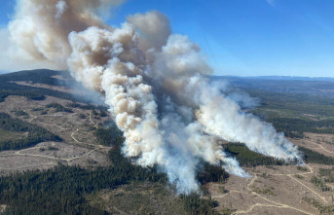The reaction to rain in Bavaria surprisingly often allows a very good localization: the warmer it is greeted, the more likely it is to be in Franconia. The gap is great. But why is that?
Munich (dpa / lby) - It's dry in Franconia. In Würzburg, Bamberg, Nuremberg and Hof, the data from the German Weather Service has shown only a few, if any, only weak precipitation. As of Wednesday, the risk of forest fires in northern Bavaria is high in some areas. The situation is different in the south of the Free State: If you look at the values for Munich, Kempten or the Hohenpeißenberg, there is also heavy precipitation in the summer months.
The south-north gradient in precipitation is typical: while it often rained more than 1500, sometimes even more than 2000 millimeters per year in and around the Alps on a long-term average from 1991 to 2020, it was just around in large parts of Franconia the 500. But why is that?
The decisive factor in Bavaria is the nature of the earth's surface, the so-called orography, as Florian Zabel from the Department of Geography at Munich's Ludwig Maximilian University (LMU) explains. In other words: how much it rains in the long term depends primarily on where the mountains are in this country.
At the edge of the Alps, things are relatively easy to explain: humid air, which often comes from the west and north-west, is forced to rise by the Alps, the largest orographic obstacle far and wide. The air is getting colder and it's raining. Therefore, even in the past very dry years at the edge of the Alps, there was hardly any drought stress in plants, says Zabel.
In Franconia - especially Lower Franconia - it is the other way round. There is a "protected location" behind various low mountain ranges, explains Zabel. And they stand in the way of the air masses on the journey to Franconia from practically every direction. They also force the air to rise and it rains - just not in Franconia, but on the way there.
By the time the air arrives in Franconia, it has already lost some of its moisture. On the other hand, it sinks from the Spessart or Odenwald to the area around Würzburg when the wind blows from the west. The result is exactly the opposite of that of an ascent: the air becomes warmer and even drier. Accordingly, there is a little more rain towards the east, where Franconian Switzerland and the Fichtelgebirge rise - at least on a long-term average.












